 Back to all articles
Back to all articles
These days, it’s hard to picture a big company in the limits of one country and one culture. It’s pretty common to be closing a deal with someone in the USA one day, chatting with your HR manager in Bali the next, and then having a virtual meeting with your team members from Germany, China and Russia by the week’s end.
Companies of all shapes and sizes are catching on to the perks of having diverse teams. Different backgrounds mean fresh ideas and different perspectives, which can really boost creativity and growth. But let’s be real – working in mixed teams can come with its own set of challenges that can make things either easier or harder, depending on how you handle them.
That’s why it’s important to get the hang of navigating a multicultural workplace. So, let’s find out how to maintain a successful cross-cultural communication in a diverse team.
Cross-cultural communication is crucial for successful team collaboration, significantly enhancing both organizational performance and team wellbeing. When team members effectively communicate with cultural considerations in mind, your company reaps several benefits:
Enhanced collaboration: Effective cross-cultural communication fosters creativity and innovation within teams. Diverse perspectives contribute to a broader range of ideas, problem-solving approaches, and decision-making strategies.
Increased global reach:, Organizations interact with clients, partners, and customers from various cultures. Understanding their needs, values, and communication preferences can lead to successful international ventures.
Reduction in costly mistakes: Miscommunication due to cultural differences can result in errors, delays, and misunderstandings, harming business relationships, productivity, and profitability. Building cultural intelligence helps mitigate these risks.
Cross-сultural сommunication holds on three basic things:
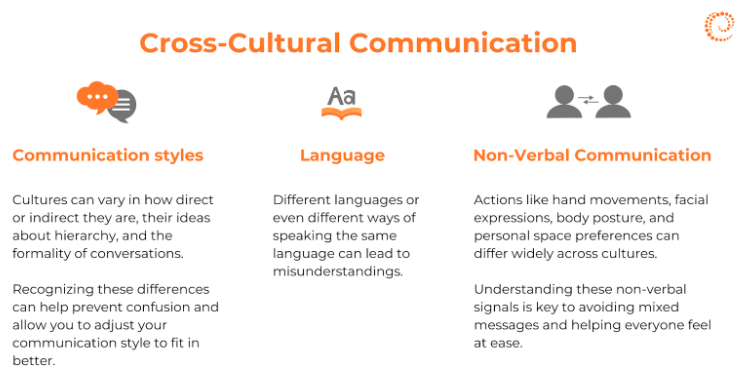
Let’s look at each of these three points in more detail.
Cross-сultural сommunication in international companies has been a topic of interest for a long time. In 2014, Erin Meyer did a study to explore how differences between cultures can impact business, which she discussed in her book, “The Culture Map: Breaking Through the Invisible Boundaries of Global Business.”
In her work, Meyer developed a straightforward system with eight scales to help us see how cultures differ from one another. This tool helps us understand how culture plays a role in working with people from different backgrounds and can assist in forming effective global teams. While some aspects of the study may rely on stereotypes and generalizations, it provides a helpful overview of the variety in business cultures around the world.
To communicate well with people from different cultures, it’s important to know that some countries are more straightforward, while others are a bit more complicated in how they convey messages.
In straightforward communication, the message is clear and easy to understand. This is often seen in places like North America and Western Europe, where people tend to say exactly what they mean, like the Dutch, who are known for being very direct.
On the other hand, in more complicated communication, people use not just words, but also things like tone of voice, facial expressions, and body language to get their message across. This style is common in places like Japan, China, and Arab countries, where relationships and keeping peace with others are very important. People there often rely on unspoken hints and shared cultural understanding to communicate.
Because of these differences, someone from a straightforward culture might see straightforward communication as rude or too blunt, while someone from a more complex culture might find straightforward messages confusing or unclear.
At Setronica, we have cross-cultural teams, too. The following nationalities form the heart of our company, so when we held our meetup, we focused on them:
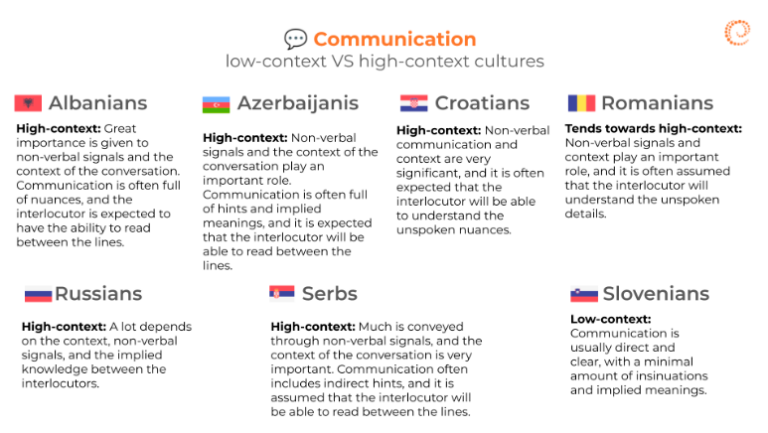
This scale talks about how different cultures see leaders. In cultures that value equality, like in the Netherlands, people see their leaders as friends and often use their first names. They’re not shy about sharing their opinions or questioning their leaders in meetings. Everyone gets to have a say when decisions are made, so teamwork and working together are really important.
On the other hand, in cultures that focus on hierarchy, people see their leaders as having more power, and they usually don’t challenge what their leaders say. Here, ranks matter a lot, and there are clear levels of authority. This kind of leadership, where the bosses make the decisions, can be found in countries like Brazil, China, France, India, Mexico, Russia, and Saudi Arabia.
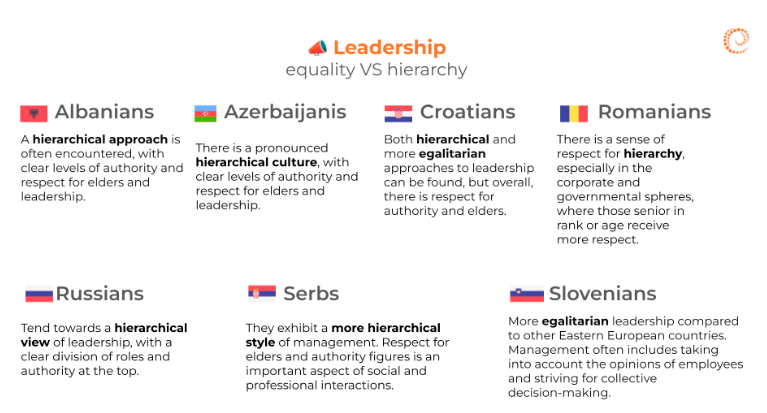
This scale is about how different cultures make decisions. In some places, everyone is involved in making a choice. They talk about what everyone thinks and only go ahead when everyone is happy with the decision. This can take a while, but once it’s settled, it sticks.
In other places, one person, often the boss, makes the final call. They might listen to others, but in the end, they decide.
Both ways of making decisions can work well, but it’s really important for teams made up of people from different cultures to talk about and agree on how they will make decisions together.
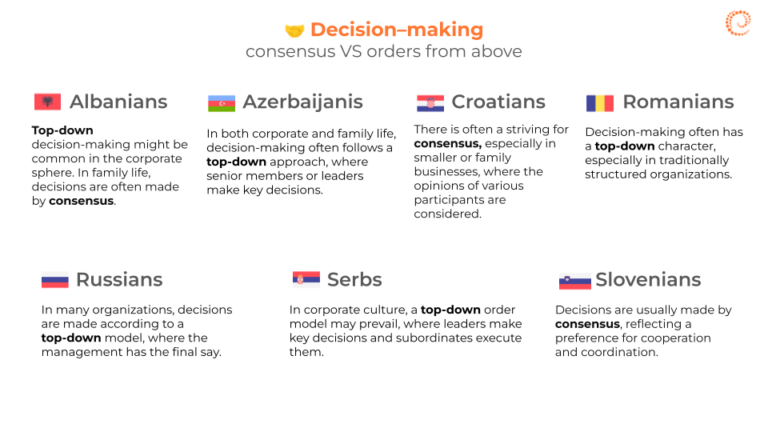
In cultures where tasks are the main focus, leaders focus on skills and getting things done right to build trust. This means doing good work and sticking to deadlines. Here, personal success is often valued more than getting along with the group, and business connections stay professional without getting personal.
On the other hand, in cultures that value relationships, trust comes from personal connections. This means spending time together and getting to know each other outside of work, like having lunch meetings, which are common in places like Belgium and Spain. In these cultures, being a good team member and sticking together is seen as more important than individual accomplishments.
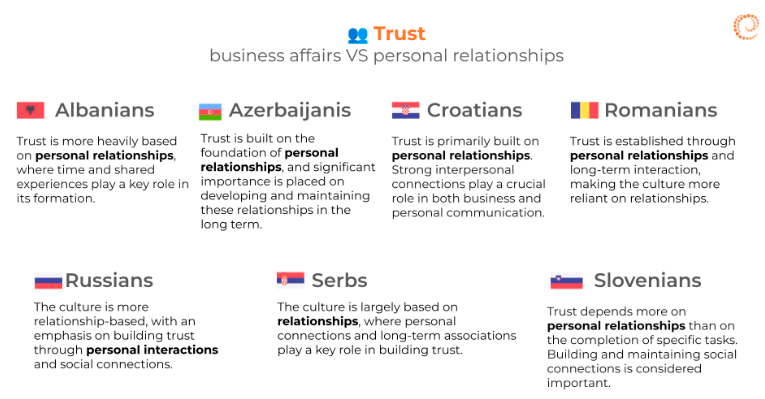
Let’s talk about how different cultures think about time and how that shapes their workdays and meetings. Some places, like Germany, the Netherlands, and the UK, like to keep things on a strict schedule. They focus on one task at a time and really care about being on time. For them, lunch happens exactly at noon because that’s when the clock says it’s time to eat.
On the other hand, there are cultures that like to juggle several things at once. They don’t stick too closely to a schedule and let the day’s events guide them. For these cultures, lunch happens when people are hungry, not at a set time.
A good way to see how a culture views time is to check out how they handle meetings. In those strict-schedule cultures, there’s a set agenda to follow, people stay focused, and wandering off-topic isn’t appreciated. But in the more flexible cultures, meetings can switch topics depending on what’s important that day. You might have several side conversations happening at the same time as people dive into different ideas as they come up.
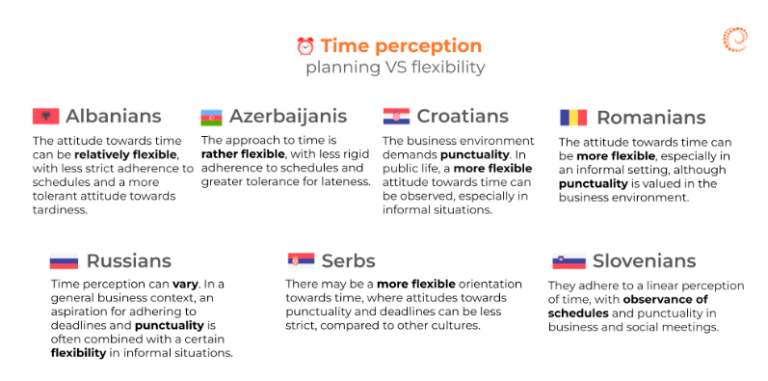
In a multicultural company, you’re likely to use English for communication since it’s the common language around the world. However, this can be tricky for non-native speakers. One confusing aspect is how polite English can be in a business context. While some cultures prefer to speak directly, English speakers often communicate in a more indirect and humble way, sometimes even downplaying their own merits. Politeness plays a key role in communication, helping to regulate the behavior of interlocutors and establish positive relationships.
There are many ways to express politeness in English, but we will focus on the following: grammatical constructions and some expressions.
Polite Requests
When asking for something, it can be nicer to use “could” or “would” instead of “can,” and adding “please” makes it even better
Not polite:
Can you email that document to me? I need it ASAP.
Better:
Would you please email that document to me? I need it ASAP.
Softeners
To make a critique feel less harsh, start with something positive
Not polite:
The conclusion needs to be improved.
Better:
The introduction is great, but the conclusion could be stronger.
Team Language
When discussing ideas as a group, using “we” and “let’s” creates a sense of teamwork. This is especially helpful if you disagree with someone’s suggestion
Not polite:
I want to make this whole section red.
Better:
How about we make just this area red and try black for the other part?
Negation Questions
You can soften a suggestion by using negative questions. This makes it feel less forceful
Not polite:
We should redesign the company logo!
Better:
Shouldn’t we redesign the company logo?
Past Continuous
Using the past continuous tense can make your statements softer and less direct. It introduces a sense of uncertainty
Not polite:
I hope we could sign the contract today.
Better:
I was hoping that we could sign the contract today.
Passive Voice
The passive voice helps to take the focus off the person and puts it on the action instead, making your words less confrontational
Not polite:
You have broken my computer!
Better:
My computer has been broken!
When we speak, we always have a reason for saying something. Every language, including English, serves a purpose. Here are some basic purposes we communicate: to greet someone, apologize, ask for clarification, make an offer, agree, thank someone, or interrupt. By understanding why you want to say something, you can choose the right words to use.
Request
If it is possible, would you be so kind to look through my papers?
If you don’t mind, would you please stop smoking?
Asking for permission
May I go now, please?
Do you mind if I watch the news?
Would it be a problem if I watched the news?
I was wondering if I could watch the news.
Polite rejection
May I go now, please?
Do you mind if I watch the news?
Would it be a problem if I watched the news?
I was wondering if I could watch the news.
Polite disagreement
I see what you’re saying, but I think…
You could be right, but don’t forget that…
Yes, that’s true, but I’m not sure that…
How to politely interrupt the interlocutor
Excuse me for interrupting, but…
If I can just come in here, …
May I interrupt here?
Non-verbal communication plays a crucial role in interactions, as it reflects emotions, confidence, and overall demeanor. Below are key non-verbal cues to consider when engaging with your cross-cultural team:
By adhering to these communication strategies, you can establish stronger connections with anyone you engage with in English, irrespective of their cultural background.
Working in cross-cultural teams presents unique challenges but also offers unparalleled opportunities for growth and innovation. By understanding and embracing the peculiarities of cross-cultural dynamics – communication styles, time perceptions, decision-making processes, trust-building mechanisms, and cultural intelligence – teams can turn potential pitfalls into powerful strengths. In doing so, they not only enhance their performance but also contribute to a richer, more diverse organizational culture that is well-equipped to thrive in the global marketplace.


